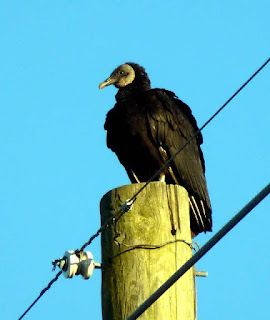The sharp end of the NASA space programme is the Kennedy
Space Centre on the east coast of Florida, about 40 miles from our campsite. It
is the rocket final assembly and launching complex, and is named after JFK
whose enthusiastic support moved the programme forward dramatically in the
60’s, resulting in a moon landing in July 1969. Following on came the space
shuttle programme, International Space Lab, Hubble Telescope and numerous
satellite launches. There is now a huge commercial aspect to NASA’s operations.
This is Guiness Book of Records country, so let’s start with
one of the World’s largest buildings, the Vehicle Assembly Building. Every name
here is reduced to an acronym, so it’s the VAB from now on, and here it is, as
we saw it from the tour bus:
All the space vehicles are assembled and maintained inside
this building and from here they are taken by crawler, a giant caterpillar
tractor, to their designated launch pad. The VAB structure is 525 feet tall
with an interior volume equal to nearly 4 times that of the Empire State
Building in New York.
The tour bus proceeds to the observation gantry, and we get
off. This is the closest location allowed for launch viewing, and on those days
it is closed to tourists. The main launch pad is LC39A, as seen from the
observation gantry. The white dome on the left is for liquid oxygen storage,
the one on the right for liquid nitrogen. These are rocket fuels.
We get off the bus again at the Apollo/Saturn V Center. The
Apollo missions were the manned moon landings and Saturn V the rocket that
propelled them there.
As a technical description of a fully loaded, 363 feet high,
2,750 tonne Saturn V rocket, I can do no better than copy this Google entry:
The
Saturn V (pronounced "Saturn Five") was an American rocket used by NASA's Apollo and Skylab programs from 1967 until 1973. A multistage liquid-fuelled
launch vehicle, NASA launched 13 Saturn V’s
from the Kennedy Space Centre, Florida with no loss of
crew or payload. It remains the tallest, heaviest, and most powerful rocket
ever brought to operational status and still holds the record for the heaviest
launch vehicle payload.
And here it is, the mighty Saturn V, totally impressive.
Before being directed to the rocket itself, we were given a simulated countdown
and launch in the very control room used for the Apollo moon missions. Very realistic
and atmospheric.
The exhibits give some idea of the high risks and cramped
conditions the astronauts endured. The re-entry capsule’s exterior shows burn
marks from the extreme heat on re-entering the earth’s atmosphere. But you do
have to stop yourself imagining a probe on the front and a shrill metallic
voice screeching “exterminate!”
Equally prone to flights of imagination are some of the
early space suits. Did space knights wear these for jousting?
This one must be for a fancy dress party, right down to the
goldfish bowl helmet and bike reflectors!
Even the lunar landing model can’t escape an alternative interpretation.
A DIY job for the local carnival. Ran out of nice strong cardboard, so finished off
the base with gold foil Christmas wrapping paper. Design based roughly on
Kellogs Corn Flakes toy.
These light-hearted asides aren’t meant to trivialise the
awe-inspiring achievements of the space programme visionaries. We gained some
understanding of the hazards, and of the courage of the men and women who made these
journeys, and of the huge commitment in manpower and resources that made it
possible.
The bus took us back to the Visitor Center where there are
many more exhibits and facilities to explore, a few of which we did. But that’s
another story. We are returning for a further visit which will hopefully
include a rocket launch.


























